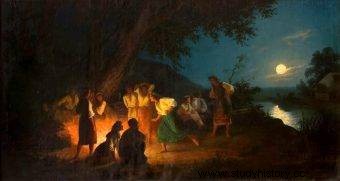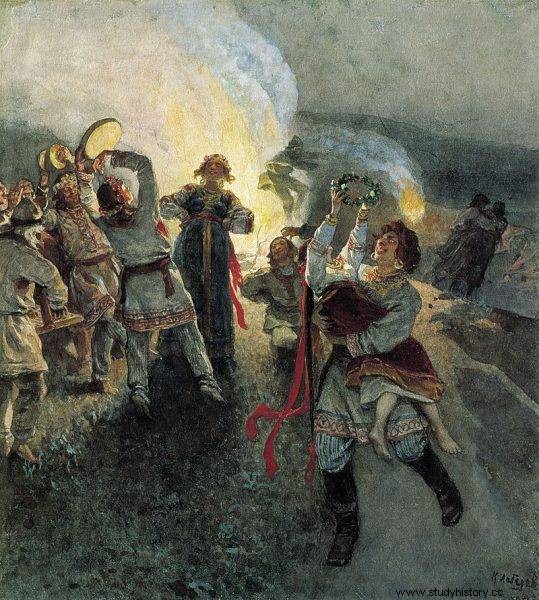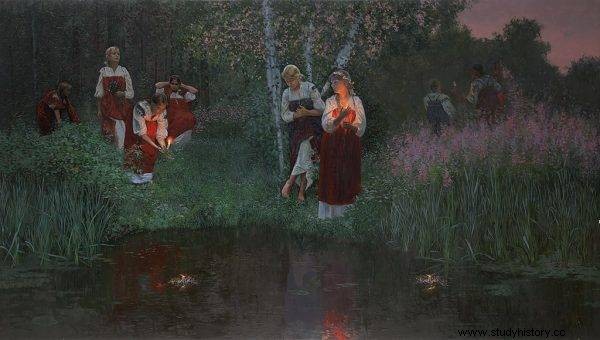Kupala Night, which is celebrated on the summer solstice, has an extremely long tradition. It was so important that Christianity had to accept it also in its calendar almost unchanged. How did it happen that a pagan festival did not get Christianized?
From the very beginning, growing Christianity was afraid of pagan customs that could hinder the spread of the new religion among other nations. When it was not possible to pull out the manifestations of the old faith from their roots, they were simply drawn into rituals, adapting them to Christian customs.

Kupała Night
This is how Midsummer Eve, celebrated on the eve of Saint John the Baptist, which falls on June 23-24, has entered the calendar of celebrations. Celebrations vary from region to region, but are usually associated with burning fires, bathing, jumping through the flames, and flying garlands on the water.
Sounds familiar? So what did the celebration of Kupala Night - the prototype of Midsummer Night look like?
Element takeover
The most famous elements of the celebration of Kupala Night are associated with water and fire. Both elements have a cleansing power in many cultures; It was no different with the Slavs too! These elements perform exactly the same function in Christianity.
It was that on the shortest night of the year water became friendly to people. The ban on bathing disappeared, and the demons who ruled over rivers and lakes gave them to use by people. For comparison - on the eve of St. John the Baptist, there was a ritual of blessing water that was supposed to have exactly the same effect.

Rites during Kupała Night
The rites of releasing wreaths were also associated with water. According to one of the theories related to this tradition, wreaths, apart from their love connotation, were also to serve as a sacrifice folded to tame the water.
And since the water was given to people, a ritual bath could take place! Taking a bath during the Kupala night was supposed to ensure not only purification of the body and soul. It was believed that it would also enhance fertility and health! And if we add a barefoot walk on the dewy grass to it, the chances of increasing one's attractiveness in the eyes of the opposite sex increased to the maximum.
Ritual of cleansing
The second element used during the Kupala night was fire. The shortest night of the year was lit by ritual bonfires. Fire is strongly associated with the element of purification and protection. During the celebrations, he was jumped over to wipe out the blame and ensure their well-being. In the fires, herbs were also burned and danced around the flames.
Throwing objects into the fire was to forget what had happened in the past and make room for new ones. Witches were also symbolically burned in this way, harming society through charms or stealing milk.
Wianuszku, bring me a beautiful boy
During the Kupala night, there were also fortune-telling and conjuring the future, now associated mainly with the love sphere. The most popular prophecy was that of the wreaths being flown on the water.

Dropping wreaths
The wreath rapidly moving away from the shore was to herald an imminent marriage. If it was swimming slowly or stopped in the bushes, the divination was interpreted the other way around. Sometimes it was even looked for as an announcement of an illegitimate pregnancy . Interestingly, the wreaths were also used by gentlemen! The more they caught, the sooner they would meet their chosen one.
But this custom could also be used by those in love to fulfill their love. Kupała Night was the moment of the year when the young people could successfully oppose the matrimonial decisions previously agreed upon by their families.
Naked in the woods
One of the most famous elements of Kupala Night was the search for a fern flower. It was commonly believed that it was connected with forest trysts. However, the Slavs firmly believed that this mythical flower existed and that the finders would bring good luck - and much more.

The fern flower
He was to endow the finder with such great power that it was worth exposing himself to the dangers of his search. And there was something to be afraid of! The appearance of the flower was accompanied by terrible circumstances, including hosts of demons, earthquakes and cataclysms . And the flower itself was only supposed to appear in the blink of an eye.
Holy herb
Herbs were an extremely important element both in the celebration of Kupala Night and St. John's Night. They were woven into wreaths, thrown into the fire. In the Catholic Church, herbs are even sacred! The most important of these are St. John's wort and thyme. For the Slavs, mugwort was also important.
St. John's wort was used not only in folk medicine but also in magical practices. Anyway, is also known under the name of witch's or St. John's herb.
How good it is that the new religion has not been able to fully eradicate the native pagan customs. Celebrating the summer solstice has become a Christian tradition and thus made it possible to preserve the memory of the old rituals. Kupała Night is a celebration of the coming summer, fertility and love. It is a celebration of the elements of fire and water. Time of opposites merging.
Midsummer night on June 23-24 is not the same as Kupala night. They can no longer be inextricably linked. Nowadays, the Slavic tradition is being revived, and the native-religious groups and the society fascinated by Slavicism celebrate the shortest night of the year again, according to the state of our knowledge about the old rituals.
Literature:
- A. Gieysztor, Mythology of the Slavs , Warsaw 2020.
- J. Krzyżanowski, Dictionary of Polish Folklore , Warsaw 1965.
- A. Paluch, Ethnological atlas of the human body and diseases , Wrocław 1995.
- A. Woźniak, Female mythical creatures in Polish and Belarusian folklore , Annals of Humanities 50:2002, issue 7, pp. 146–157.
